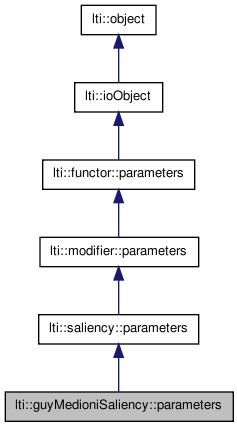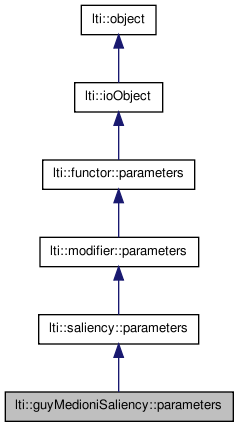

|
latest version v1.9 - last update 10 Apr 2010 |
|
the parameters for the class guyMedioniSaliency More...
#include <ltiGuyMedioniSaliency.h>


Public Member Functions | |
| parameters () | |
| parameters (const parameters &other) | |
| ~parameters () | |
| const char * | getTypeName () const |
| parameters & | copy (const parameters &other) |
| parameters & | operator= (const parameters &other) |
| virtual functor::parameters * | clone () const |
| virtual bool | write (ioHandler &handler, const bool complete=true) const |
| virtual bool | read (ioHandler &handler, const bool complete=true) |
Public Attributes | |
| float | highCurvatureDecay |
| float | proximityDecay |
| float | threshold |
| int | maxFieldRadius |
| float | fieldThreshold |
the parameters for the class guyMedioniSaliency
| lti::guyMedioniSaliency::parameters::parameters | ( | ) |
default constructor
Reimplemented from lti::saliency::parameters.
| lti::guyMedioniSaliency::parameters::parameters | ( | const parameters & | other | ) |
copy constructor
| other | the parameters object to be copied |
Reimplemented from lti::saliency::parameters.
| lti::guyMedioniSaliency::parameters::~parameters | ( | ) | [virtual] |
destructor
Reimplemented from lti::functor::parameters.
| virtual functor::parameters* lti::guyMedioniSaliency::parameters::clone | ( | ) | const [virtual] |
returns a pointer to a clone of the parameters
Reimplemented from lti::saliency::parameters.
| parameters& lti::guyMedioniSaliency::parameters::copy | ( | const parameters & | other | ) |
copy the contents of a parameters object
| other | the parameters object to be copied |
Reimplemented from lti::saliency::parameters.
| const char* lti::guyMedioniSaliency::parameters::getTypeName | ( | ) | const [virtual] |
returns name of this type
Reimplemented from lti::saliency::parameters.
| parameters& lti::guyMedioniSaliency::parameters::operator= | ( | const parameters & | other | ) |
copy the contents of a parameters object
| other | the parameters object to be copied |
| virtual bool lti::guyMedioniSaliency::parameters::read | ( | ioHandler & | handler, | |
| const bool | complete = true | |||
| ) | [virtual] |
read the parameters from the given ioHandler
| handler | the ioHandler to be used | |
| complete | if true (the default) the enclosing begin/end will be also written, otherwise only the data block will be written. |
Reimplemented from lti::modifier::parameters.
| virtual bool lti::guyMedioniSaliency::parameters::write | ( | ioHandler & | handler, | |
| const bool | complete = true | |||
| ) | const [virtual] |
write the parameters in the given ioHandler
| handler | the ioHandler to be used | |
| complete | if true (the default) the enclosing begin/end will be also written, otherwise only the data block will be written. |
Reimplemented from lti::modifier::parameters.
Field Threshold.
The extension field will be computed in a discrete grid. Depending on the highCurvatureDecay and proximityDecay values, the size of the grid needs to be adapted. This threshold determines which values cannot be neglected and therefore controls the size (and indirectly speed) of the algorithm. More precisely, this value determinies the the minimum valid value of the x-coordinate.
This value must be greater than 0 and less than 1
Default value: 0.1f; (With default values, about 57x57 kernel)
Parameter used in the creation of the Extension Field.
It controls the curvature decay, and was named B in the original paper. This value must be greater than zero.
Default value: 2.85f
In case threshold is too low, do not allow the field radius become bigger than the given value.
Default value: 128
Parameter used in the creation of the Extension Field.
It controls the proximity decay, and was named A in the original paper. This number must be greater than zero.
Default value: 0.003f